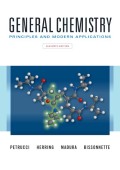
(a)
Interpretation:
To calculate the mass of product obtained.
Concept introduction:
When Ca is heated in air, below reaction is take place.
Molar mass of Ca is
(b)
Interpretation:
To calculate the mass of
Concept introduction:
The mass of product formed from the starting Ca is differ from
(c)
Interpretation:
To calculate the mass percent of
Concept introduction:
To calculate the mass percent of
Want to see the full answer?
Check out a sample textbook solution
Chapter 21 Solutions
EBK GENERAL CHEMISTRY
- Phosphorus occurs naturally in the form of fluorapatite, CaF2 3Ca3(PO4)2. The dot indicates 1 part CaF2 to 3 parts Ca3(PO4)2. This mineral is reacted with an aqueous solution of H2SO4 in the preparation of a fertilizer. The products are phosphoric acid, hydrogen fluoride, and gypsum, CaSO4 2H2O. Write the balanced equation describing this process.arrow_forwardWrite balanced chemical equations for the following reactions: (a) metallic aluminum burned in air (b) elemental aluminum heated in an atmosphere of Chlorine (c) aluminum heated in hydrogen bromide gas (d) aluminum hydroxide added to a solution of nitric acidarrow_forwardWrite balanced chemical equations for the following reactions: (a) zinc metal heated in a stream of oxygen gas (b) zinc carbonate heated until loss of mass stops (c) zinc carbonate added to a solution 0f acetic acid, CH3CO2H (d) zinc added to a solution of hydro-bromic acidarrow_forward
- Three reactions very important to the semiconductor industry are The reduction of silicon dioxide to crude silicon, SiO2(s) + 2 C(s) → Si(s) + 2 CO(g) ΔrH° = 689.9 kJ/mol The formation of silicon tetrachloride from crude silicon, Si(s) + 2 Cl2(g) → SiCl4(g) ΔrH° = −657.01 kJ/mol The reduction of silicon tetrachloride to pure silicon with magnesium, SiCl4(g) + 2 Mg(s) → 2 MgCl2(s) + Si(s) ΔrH° = −625.6 kJ/mol Calculate the overall enthalpy change when 1.00 mol sand, SiO2, changes into very pure silicon by this series of reactions.arrow_forwardIdentify the oxidation state of Cl in Ba(ClO2)2. Identify the oxidation state of Cl in ClF+4.arrow_forwardWrite the chemical formula for cesium acetatearrow_forward
- What mass of magnesium chloride would be required to produce 12.85 g of magnesium hydroxide by the following reaction? MgCl2 + NaOH --> Mg(OH)2 + NaClarrow_forwardBarium metel was quantitatively precipitaded from 1.52g sample of BaCl2+2H2O. The mass of the barium that was collected was 0.844g. How do I calculate the experimental mass percent of barium in the sample?arrow_forwardPlease answer questions 3a and 3b. Questions are provided in the attached image. Thank you.arrow_forward
- Cu(OH)2(s) → CuO(s)+H2O(l) write the name of the product and the name of the solid product.arrow_forwardPredict the reactants of this chemical reaction. That is, fill in the left side of the chemical equation. Be sure the equation you submit is balanced. (You can edit both sides of the equation to balance it, if you need to.) Note: you are writing the molecular, and not the net ionic equation. [] + KClO(aq) + H,O(1) · X Śarrow_forwardAnalyze and solve the following problems. Provide complete solutions. Write all working equations used and box the final answers. 2. Pure lead is obtained from galena, PbS, deposits through the following reactions. 2PbS(s) + 30₂(g) → 2PbO(s) + 2SO₂(g) PbO(s) + C(s) → Pb(l) + CO(g) Determine the mass of galena used to produce 77.3 kg of pure lead if the first and second reactions have 100% and 89% yield, respectively. (Ans.: 100.3 kg)arrow_forward
 Chemistry: The Molecular ScienceChemistryISBN:9781285199047Author:John W. Moore, Conrad L. StanitskiPublisher:Cengage Learning
Chemistry: The Molecular ScienceChemistryISBN:9781285199047Author:John W. Moore, Conrad L. StanitskiPublisher:Cengage Learning Chemistry for Engineering StudentsChemistryISBN:9781337398909Author:Lawrence S. Brown, Tom HolmePublisher:Cengage Learning
Chemistry for Engineering StudentsChemistryISBN:9781337398909Author:Lawrence S. Brown, Tom HolmePublisher:Cengage Learning ChemistryChemistryISBN:9781305957404Author:Steven S. Zumdahl, Susan A. Zumdahl, Donald J. DeCostePublisher:Cengage Learning
ChemistryChemistryISBN:9781305957404Author:Steven S. Zumdahl, Susan A. Zumdahl, Donald J. DeCostePublisher:Cengage Learning General Chemistry - Standalone book (MindTap Cour...ChemistryISBN:9781305580343Author:Steven D. Gammon, Ebbing, Darrell Ebbing, Steven D., Darrell; Gammon, Darrell Ebbing; Steven D. Gammon, Darrell D.; Gammon, Ebbing; Steven D. Gammon; DarrellPublisher:Cengage Learning
General Chemistry - Standalone book (MindTap Cour...ChemistryISBN:9781305580343Author:Steven D. Gammon, Ebbing, Darrell Ebbing, Steven D., Darrell; Gammon, Darrell Ebbing; Steven D. Gammon, Darrell D.; Gammon, Ebbing; Steven D. Gammon; DarrellPublisher:Cengage Learning Chemistry & Chemical ReactivityChemistryISBN:9781337399074Author:John C. Kotz, Paul M. Treichel, John Townsend, David TreichelPublisher:Cengage Learning
Chemistry & Chemical ReactivityChemistryISBN:9781337399074Author:John C. Kotz, Paul M. Treichel, John Townsend, David TreichelPublisher:Cengage Learning Chemistry & Chemical ReactivityChemistryISBN:9781133949640Author:John C. Kotz, Paul M. Treichel, John Townsend, David TreichelPublisher:Cengage Learning
Chemistry & Chemical ReactivityChemistryISBN:9781133949640Author:John C. Kotz, Paul M. Treichel, John Townsend, David TreichelPublisher:Cengage Learning





